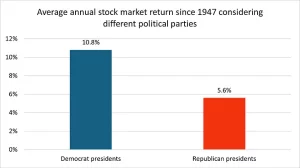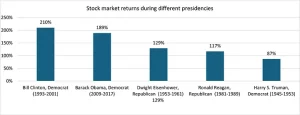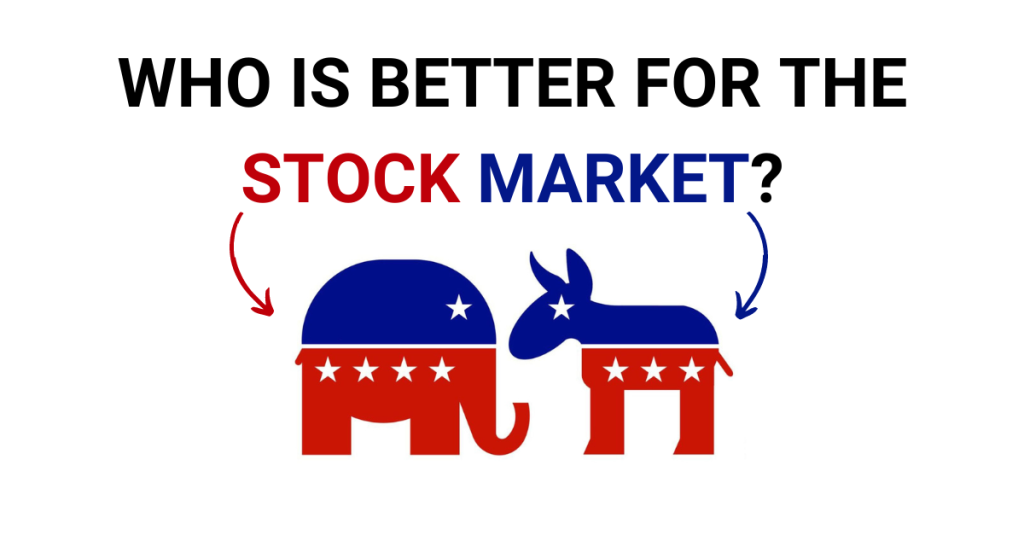This year, the US will witness presidential elections. These events carry significant global implications, influencing not only the political landscape but also exerting an impact on the international stock market. The stock market’s relationship with political events, especially elections, is a complex interplay of various factors. As investors, understanding these dynamics becomes crucial for making informed decisions and navigating uncertainties that often accompany election periods.
The debate over which political party is better for the stock market has been a longstanding and contentious one. Democrats and Republicans often have differing economic philosophies and policy priorities, leading to distinct approaches to fiscal and monetary matters. In this article, we will explore the historical context and key economic policies of both parties, aiming to provide a nuanced perspective on their respective impacts on the economy and the stock market.
Unpacking different economic policies
To comprehend the present, it is often useful to look to the past. Examining historical stock market performances during election years provides valuable insights into patterns and trends. The impact of political uncertainty on investor behavior is often reflected in market fluctuations, showcasing the market’s sensitivity to electoral outcomes. As such, it’s useful to understand what each respective party’s economic policy is to anticipate how electoral outcomes will influence the markets.
Democratic economic policy
Firstly, let’s start with the Democratic Party’s economic policies:
- Government intervention: Democrats generally advocate for a more active role of the government in the economy. They often support policies such as increased regulations, social safety nets, and progressive taxation to address income inequality and provide a stable foundation for economic growth.
- Infrastructure spending: Democrats tend to prioritize infrastructure development to stimulate economic activity. Investments in areas like transportation, energy, and technology are believed to create jobs and enhance overall economic productivity.
- Social programs: Democrats emphasize social programs, such as healthcare and education, as essential components of a thriving society. While these initiatives may lead to higher government spending, supporters argue that they contribute to a healthier and more educated workforce, ultimately benefiting the economy in the long run.
Republican economic policy
And for the Republican party:
- Free market approach: Republicans generally favor a free-market approach with minimal government intervention. They advocate for lower taxes, reduced regulations, and limited government involvement in the economy, aiming to create an environment conducive to business growth and innovation.
- Tax cuts: Republicans often champion tax cuts, both for individuals and corporations, as a means to stimulate investment, job creation, and overall economic expansion. The belief is that reduced tax burdens lead to increased consumer spending and business investment.
- Deregulation: Republicans typically support deregulation, arguing that it allows businesses to operate more freely and efficiently. They contend that fewer regulatory hurdles encourage entrepreneurship and foster a competitive business environment.
Reflecting on previous historical performance
Some investors harbored concerns about the potential impact of a Joe Biden victory on the stock market. However, these apprehensions seem to have been unfounded, given that the S&P has yielded a 20% return since his inauguration, despite the ongoing battle against inflation, corresponding Federal Reserve interventions, and the Russian invasion. Contrary to popular belief, historical data suggests that stock market performance is superior under Democratic presidents compared to their Republican counterparts.
As per Liberum, a U.K.-based investment bank, the average annual return since 1947 under Democratic presidents stands at 10.8%, significantly outpacing the 5.6% return observed under Republican presidents.

The most impressive stock market performance post-World War II occurred during Bill Clinton’s presidency, witnessing a staggering 210% increase in the S&P 500 from 1993 to 2001. The second-highest return came under Barack Obama’s eight-year tenure, with a 189% increase from 2009 to 2017.
Following closely are two Republican presidents: Dwight Eisenhower (1953–1961) with a 129% increase and Ronald Reagan (1981–1989) with a 117% rise.
Completing the top five is Democrat Harry S. Truman, overseeing an 87% growth in the S&P during his eight-year term (1945–1953).
How did Donald Trump fare during his four years in office? Remarkably well, especially considering the challenges of 2020. The S&P 500 experienced a 63% surge during Trump’s tenure, translating to approximately a 1.3% per month return. If he had won re-election and served two terms, this would have resulted in a 126% return, placing him fourth on the post-World War II list, just ahead of Ronald Reagan.

The importance of context
However, context is crucial when evaluating U.S. presidencies.
It’s essential to highlight that Obama assumed office as stocks were hitting multi-year lows amidst the worst recession since the Great Depression. Obama benefited from the subsequent rebound, although one could argue that he played a substantial role in facilitating it.
Conversely, President Trump faced the unfortunate timing of being in office during the most severe global pandemic in over a century, leading to a year-long stay-at-home order and economic downturn. The debate over how his handling of COVID-19 affected the economy and, by extension, the stock market is complex and subjective.
Biden is currently benefiting from global post-Covid reopening trends and a resilient U.S. consumer. This could result in a post-recession surge for Joe Biden, reminiscent of the one he and President Obama experienced 12 years ago.
Conclusion: So, which political party is better for the stock market?
In essence, stock market rallies can endure for extended periods, traverse political affiliations, and withstand times of profound political unrest. Despite Wall Street historically favoring Democratic presidencies, there have been thriving bull markets during Republican administrations.
Therefore, while celebrating the impressive stock market performance under Trump is warranted, there should be no undue concern about a market correction under Biden, at least not one directly tied to the return of a Democrat to office. Of course, the future is uncertain and the past does not predict future market performances, so there is no guarantee for what will happen in November. The best way to prepare for possible market volatility is to take a long-term perspective: staying focused on broader economic trends, global markets, and personal goals. No matter what happens politically, there are long-term trends that will generate opportunities and also challenges, such as the digital era or cyber security, which have a more important weight than whoever is going to end up in the White House.
Guarantee investment success with One-Signal
A fail-proof approach to seeing considerable returns on your stock market investments is the use of trading signals. One-Signal is a market-leading trading signals provider, developed after years of proprietary research and successfully testing our findings in the markets. Relying purely on sentiment indicators, we provide our subscribers with clear daily signals, fostering a smarter and more efficient trading strategy based on accurate information, irrespective of market trends, offering a valuable tool for those seeking consistent and profitable results.
Sign up for One-Signal and boost your trading performance, no matter what the political climate looks like. Alternatively, get in touch with us to learn more.
**Disclaimer:**
This article is provided for informational purposes only and does not constitute investment advice, endorsement, or recommendation. The content within is intended to be general and should not be construed as professional financial or investment advice. Readers are encouraged to conduct their research and consult with a qualified financial advisor before making any investment decisions. The author and publisher of this article disclaim any liability for financial decisions made based on the information provided herein. Investments carry inherent risks, and individuals should exercise caution and diligence when considering investment options.

